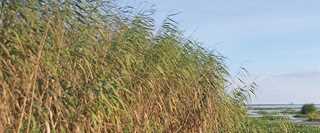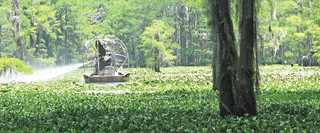Invasive species are a serious threat to wetlands and waterfowl in many areas

By Andi Cooper
You may not know it, but our country's waterways are under attack. From hydrilla, water hyacinth, and giant salvinia to zebra mussels, Eurasian watermilfoil, and phragmites, invasive species are spreading rapidly in wetlands across the United States. Waterfowl habitat is being lost at astonishing rates, and waterfowl hunters have an important role to play in stopping it.
Because invasive species originate in foreign environments, they often have no natural predators, and native species have no defenses against them. They reproduce much faster than many native plants that provide important food and cover for waterfowl and other wildlife, replacing productive habitats with dense stands of a single plant species and reducing biodiversity. Left unchecked, these aquatic invaders can ruin wetlands, lakes, and rivers used for hunting, fishing, and other recreation. On a larger scale, they can degrade the functions and values of entire wetland systems.
Whether introduced intentionally via the pet and plant trades or brought in unknowingly on shipping containers and boats, invasive species spread quickly once they are released in natural habitats. In Florida and other parts of the Deep South, one of the most common and widespread invasive species is hydrilla, an aquatic plant commonly used in aquariums. Hydrilla infestations can choke wetlands and waterways, and the plant harbors toxic algae, which can cause neurological damage in bald eagles, waterfowl, reptiles, and amphibians. A more recent invader is giant salvinia. Native to Brazil, this aquatic fern can double its surface area in only three days and grows in mats that are thick enough to support a person's weight.
Another invasive species that poses a grave threat to wetlands is water hyacinth, a flowering plant from South America that is used as an ornamental species in fountains and ponds. In the wild, water hyacinth forms dense mats that block sunlight, which is needed to sustain submersed aquatic vegetation and other aquatic life. Moreover, water hyacinth crowds out native plants that root in shallow water and stabilize wetland soils. Following a hard freeze or saltwater exposure, the vegetation dies back, leaving wetlands and other water bodies empty and vulnerable to erosion. This further degrades the habitat by increasing water depth and turbidity, which can prevent desirable plants from becoming reestablished.
Invasive species threaten not only native plants and animals but also people, property, and the economy. It has been estimated that, worldwide, the damage inflicted by invasive species exceeds $1.4 trillion, or almost 5 percent of the global economy. In the United States, the annual economic impacts total more than $120 billion. In the Great Lakes watershed, zebra mussels clog municipal and industrial intake pipes, causing millions of dollars in damage each year. By impacting water filtration plants and power plant cooling reservoirs, these tiny mollusks can be significant threats to human health and safety. For owners of lakefront property, Eurasian watermilfoil can be a serious problem. In Vermont, for example, this invasive aquatic plant, which forms dense mats that can block access to docks and boat houses, has reduced lakefront property values by as much as 16 percent.
Controlling invasive species is an expensive business. In most cases, eliminating them is nearly impossible once they have become established, and control measures must be conducted on an annual basis to keep them from spreading. In 2011, the U.S. Department of the Interior spent approximately $100 million on invasive species prevention, early detection, control, management, and habitat restoration. In the Great Lakes, more than $200 million is spent annually to control nonnative species carried in the ballasts or hulls of ships. Given the environmental and economic stakes involved, these expenditures are justified and will almost certainly need to be increased in the future to keep invasive species in check.
From state and federal agencies to private individuals and nonprofit groups, the battle to prevent the spread of invasive species and manage their impacts is being waged on multiple fronts. For waterfowlers, anglers, and others who enjoy our nation's wetlands and waterways, learning to identify invasive species and alerting property owners and wetland managers of their presence will help prevent them from spreading. Early detection is essential because it's much more efficient to control invasive species before they become well established.
Most state agencies have developed online reporting systems for invasive species. Some provide a list of known infested areas. Many invasive plants can colonize an entire area from one small fragment of vegetation that hitched a ride on someone's waders or boots. Careful cleaning of gear, including boats, boots, trailers, dogs, and decoys is vital to protecting our favorite hunting areas.
"Waterfowl hunters have to go where the birds are," said Jeanne Scherer, aquatic invasive species outreach specialist for the University of Wisconsin Extension Service. "But before hunters move from one hunting spot to the next, they should make sure they aren't accidentally bringing any aquatic invasive species along for the ride. Just a few minutes of preventive action can protect your hunting tradition for generations to come."

Photo © ANDI COOPER, DU
Phragmites: Good, Bad, or Buggy?
Phragmites, also known as roseau cane or common reed, is a native grass found in many southern wetlands, but this prolific plant and its European subspecies are considered noxious weeds in much of the country. Growing in dense stands that can crowd out other vegetation, phragmites can displace native plants, such as wild rice and cattails, that are beneficial to waterfowl and other wildlife. In Louisiana, however, phragmites plays a crucial role in holding wetland soils in place along the coast. Unfortunately, a new invasive species, the roseau cane scale or mealy bug, is wiping out large stands of the vegetation in coastal marshes. Moving phragmites from one place to another accelerates the spread of not only the vegetation but also the roseau cane scale. As a result, using phragmites as blind material is strongly discouraged and is prohibited by law in certain areas.

Photo © USGS
You Can Help Stop Invasive Species
Waterfowlers, anglers, and others who enjoy our nation's wetlands, rivers, and lakes can be the first line of defense against the spread of invasive species. In addition to familiarizing yourself with invasive species in your area and reporting sightings to landowners and wetland managers, take the following precautions immediately after you leave the water:
Ducks Unlimited uses cookies to enhance your browsing experience, optimize site functionality, analyze traffic, and deliver personalized advertising through third parties. By continuing to use this site, you agree to our use of cookies. View Privacy Policy